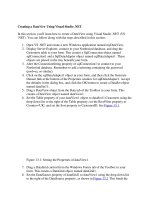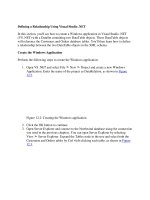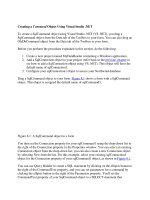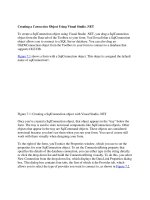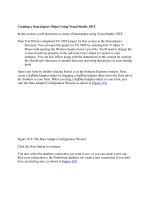Software testing using visual studio 2012
Bạn đang xem bản rút gọn của tài liệu. Xem và tải ngay bản đầy đủ của tài liệu tại đây (9.97 MB, 444 trang )
Software Testing using
Visual Studio 2012
Learn different testing techniques and features of
Visual Studio 2012 with detailed explanations and
real-time samples
Satheesh Kumar N
Subashni S
BIRMINGHAM - MUMBAI
Software Testing using Visual Studio 2012
Copyright © 2013 Packt Publishing
All rights reserved. No part of this book may be reproduced, stored in a retrieval
system, or transmitted in any form or by any means, without the prior written
permission of the publisher, except in the case of brief quotations embedded in
critical articles or reviews.
Every effort has been made in the preparation of this book to ensure the accuracy
of the information presented. However, the information contained in this book is
sold without warranty, either express or implied. Neither the author, nor Packt
Publishing, and its dealers and distributors will be held liable for any damages
caused or alleged to be caused directly or indirectly by this book.
Packt Publishing has endeavored to provide trademark information about all of the
companies and products mentioned in this book by the appropriate use of capitals.
However, Packt Publishing cannot guarantee the accuracy of this information.
First published: December 2010
Second Edition: July 2013
Production Reference: 1190713
Published by Packt Publishing Ltd.
Livery Place
35 Livery Street
Birmingham B3 2PB, UK.
ISBN 978-1-84968-954-0
www.packtpub.com
Cover Image by Artie Ng ()
Credits
Authors
Satheesh Kumar N
Project Coordinator
Anugya Khurana
Subashni S
Proofreader
Reviewers
Dan McMahon
Ahmed Ilyas
Ken Tucker
Hulot
Kalyan
Acquisition Editor
Anthony Lowe
Lead Technical Editor
Mayur Hule
Technical Editors
Ruchita Bhansali
Krishnaveni Haridas
Pratik More
Anita Nayak
Larissa Pinto
Indexer
Tejal Soni
Production Coordinator
Kyle Albuquerque
Cover Work
Kyle Albuquerque
About the Authors
Satheesh Kumar N holds a Bachelor’s degree in Computer Science engineering
and has around 17 years of experience in managing the software development life
cycle, developing live projects, and program management. He started his career by
developing software applications using Borland software products. He worked for
multiple organizations in India, the UAE, and the US. His main domain expertise is
in retail and he is currently working in Bangalore as a Program Delivery Manager for
the top retailer in UK. He is currently handling five agile scrum teams for delivering
the website features. His experience also includes implementation and customization
of Microsoft Dynamics for an automobile sales company in UAE. He works with the
latest Microsoft technologies and has published many articles on LINQ and other
features of .NET. He is a certified PMP (Project Management Professional).
He has also authored Software Testing using Visual Studio Team System 2008 and
Software Testing using Visual Studio 2010 for Packt Publishing.
I would like to thank my wife for helping me in co-authoring and
supporting me in all the ways to complete this book. I would also
like to thank my family members and friends for their continuous
support in my career and success.
Subashni S holds a Bachelor’s Degree in Computer Science engineering and
has around 15 years of experience in software development and testing life cycle,
project, and program management. She is a certified PMP (Project Management
Professional), CSTM (Certified Software Test Manager), and ITIL V3 Foundation
certified. She started her career as a DBA in Oracle 8i technology, and later
developed many software applications using Borland software products for a
multinational company based in Chennai, and then moved to Bangalore. She is
presently working for a multinational company, in the area of Project Management
for developing and testing projects. She is also currently working for one of the top
multinational companies headquartered at Austin, Texas.
She has also authored Software Testing using Visual Studio Team System 2008 and
Software Testing using Visual Studio 2010 for Packt Publishing.
I would like to thank my husband for helping me in co-authoring
and supporting me in all the ways to complete this book. I would
also like to thank my other family members and friends for their
continuous support in my career and success.
About the Reviewers
Ahmed Ilyas has a BENG degree from Napier University in Edinburgh, Scotland,
where he majored in software development. He has 15 years of professional
experience in software development.
After leaving Microsoft, he has ventured into setting up his consultancy company
offering the best possible solutions for a magnitude of industries and providing
real world answers to those problems, and only uses the Microsoft stack to build
these technologies and be able to bring in the best practices, patterns, and software
to his client base to enable long-term stability and compliance in the ever-changing
software industry. He has also tried to improve software developers around the
globe, pushing the limits in technology.
This went on to being awarded three times the MVP in C# by Microsoft for
“providing excellence and independent real world solutions to problems that
developers face.”
With the breadth and depth of the knowledge he has obtained not only from his
research, but also with the valuable wealth of information and research at Microsoft,
the motivation and inspirations come from this, with 90 percent of the world using at
least one form of Microsoft technology.
Ahmed Ilyas has worked for a number of clients and employers. With the great
reputation that he has, this has resulted in having a large client base for his
consultancy company, Sandler Ltd (UK) which includes clients from different
industries, from media to medical and beyond. Some clients have included him on
their “approved contractors/consultants” list which include ICS Solution Ltd and
has been placed on their “DreamTeam” portal and also CODE Consulting/EPS
Software (www.codemag.com) (based in USA).
Ahmed Ilyas has also been involved in the past in reviewing books for Packt
Publishing and wish to thank them for the great opportunity once again.
I would like to thank the author/publisher of this book for giving
me the great honor and privilege in reviewing the book. I would also
like to thank my client base and especially Microsoft Corporation
and my colleagues over there for enabling me to become a reputable
leader as a software developer in the industry, which is my passion.
Ken Tucker is a Microsoft MVP from 2003-2013. He has also worked for Seaworld
Parks and Entertainment.
I would like to thank my wife Alice-Marie.
Carlos Hulot has been working in the IT area for more than 20 years in different
capabilities, from software development, project management to IT marketing,
product development and management. Carlos has worked for multinational
companies such as Royal Philips Electronics, PricewaterhouseCoopers, and Microsoft.
Currently Carlos is working as an independent IT consultant. Carlos is a Computer
Science lecturer in two Brazilian universities. Carlos holds a Ph.D. in Computer
Science and Electronics from the University of Southampton, UK, and a B.Sc. in
Physics from University of São Paulo, Brazil.
Kalyan Bandarupalli is currently working in Oxford University, UK. His
professional career started as a software engineer and then senior software developer
and software architect. He is a senior consultant, who uses Microsoft technologies
to develop applications. Since 2003, he has been working as a Microsoft technology
developer.
He was far more concerned about the technical implementation of software, but
in the past few years focus has changed to more architectural implementation of
software. He recently (June 2008) started a blog (www.techbubbles.com), because
he wanted to share his learning experience to help other people learn about new
technologies in Microsoft software. This blog helps IT professionals and developers
around the world to develop applications using Microsoft technologies.
www.PacktPub.com
Support files, eBooks, discount offers and more
You might want to visit www.PacktPub.com for support files and downloads related to
your book.
Did you know that Packt offers eBook versions of every book published, with PDF and ePub
files available? You can upgrade to the eBook version at www.PacktPub.com and as a print
book customer, you are entitled to a discount on the eBook copy. Get in touch with us at
for more details.
At www.PacktPub.com, you can also read a collection of free technical articles, sign up
for a range of free newsletters and receive exclusive discounts and offers on Packt books
and eBooks.
TM
Do you need instant solutions to your IT questions? PacktLib is Packt’s online digital book
library. Here, you can access, read, and search across Packt’s entire library of books.
Why Subscribe?
•
Fully searchable across every book published by Packt
•
Copy and paste, print and bookmark content
•
On demand and accessible via web browser
Free Access for Packt account holders
If you have an account with Packt at www.PacktPub.com, you can use this to access PacktLib
today and view nine entirely free books. Simply use your login credentials for immediate access.
Instant Updates on New Packt Books
Get notified! Find out when new books are published by following @PacktEnterprise on
Twitter, or the Packt Enterprise Facebook page.
Table of Contents
Preface1
Chapter 1: Visual Studio 2012 Test Types
7
Software testing in Visual Studio 2012
Testing as part of software development life cycle
Types of testing
Unit testing
Manual testing
Exploratory testing
Web performance tests
Coded UI test
Load testing
Ordered test
Generic test
Test management in Visual Studio 2012
Introduction to testing tools
8
9
11
12
14
15
16
17
18
20
21
21
22
Microsoft Test Manager
28
Test Explorer
Code coverage results
Connecting to Team Project
Test Plans, Suites, and test cases
Defining test cases
Lab Center
25
28
29
30
31
32
Summary33
Chapter 2: Test Plan, Test Suite, and Manual Testing
Test Plan
Test Suite and its types
Static Test Suites
Query-based Test Suites
Requirement-based Test Suites
35
36
41
42
44
45
Table of Contents
Running manual tests
47
Action recording
56
Shared steps and action recording for shared steps
59
Creating shared steps
59
Action recording for shared steps
62
Adding parameters to manual tests
62
Summary66
Chapter 3: Automated Tests
Coded UI tests from action recordings
Files generated for coded UI test
67
68
73
CodedUITest1.cs73
UIMap.Designer.cs74
UIMap.cs75
UiMap.uitest76
Data-driven coded UI test
80
Adding controls and validation to coded UI test
82
Summary88
Chapter 4: Unit Testing
89
Creating unit tests
Assert statements
Types of Assert statements
90
93
94
Assert94
StringAsserts107
CollectionAssert111
AssertFailedException119
UnitTestAssertionException120
ExpectedExceptionAttribute120
Unit Tests and Generics
123
Data-driven unit testing
126
Unit Testing using Fakes
132
Stubs132
Shims137
Difference between Stubs and Shims
137
Code coverage unit test
138
Blocks and lines
140
Excluding elements
141
Summary142
Chapter 5: Web Performance Test
Creating the web performance test
Recording a test
Adding comments
Cleaning the recorded tests
[ ii ]
143
145
146
152
153
Table of Contents
Copying the requests
Adding loops
153
153
Web performance test editor
Web test properties
Web test request properties
Other request properties
158
160
161
164
Form POST parameters
164
QueryString parameters
165
Extraction rules
166
Validation rules
171
Transactions174
Conditional rules
Toolbar properties
176
181
Add data source
Setting credentials
Add recording
Parameterize web server
Adding a web test plugin
Debugging and running the web test
Settings in the .testsettings file
181
184
185
186
189
191
192
General192
Roles194
Data and Diagnostics
195
Deployment197
Setup and Cleanup Scripts
198
Hosts199
Test Timeouts
199
Unit test
200
Web test
201
Running the test
203
Web Browser
204
Request204
Response205
Context205
Details206
Summary207
Chapter 6: Advanced Web Testing
Dynamic parameters in web testing
Coded web test
Generating code from a recorded test
Transactions in coded tests
Custom code
Adding a comment
Running the coded web test
Debugging coded web test
[ iii ]
209
210
212
213
218
219
219
220
222
Table of Contents
Custom rules
224
Extraction rules
224
Validation rules
228
Summary232
Chapter 7: Load Testing
233
Specifying a scenario
Counter sets
Run settings
239
248
250
Creating a Load Test
Load Test Wizard
234
236
Editing Load Tests
262
Storing results in the central result store
Running the Load Test
Analyzing and exporting Test Results
268
270
272
Using Test Controller and Test Agents
288
Adding context parameters
Graphical view
Summary view
Tables view
Detail view
Exporting to Microsoft Excel
Test Controller and Test Agent configuration
267
272
275
277
279
280
289
Summary296
Chapter 8: Ordered and Generic Tests
297
Chapter 9: Managing and Configuring Tests
309
Ordered tests
298
Creating an ordered test
298
Executing an ordered test
300
Generic tests
301
Creating a generic test
302
The summary results file
304
Summary308
Using Test settings
The General option
The Roles option
Data and Diagnostics
The Deployment section
Setup and Cleanup Scripts
The Hosts option
The Test Timeouts option
The Unit Test option
Editing the Test Run configuration file
310
311
312
313
316
317
318
319
320
322
[ iv ]
Table of Contents
The Web Test option
324
Configuring unit tests using the .runsettings file
325
Summary326
Chapter 10: The Command Line
VSTest.Console utility
Running tests using VSTest.Console
The /Tests option
The /ListTests option
MSTest utility
Running a test from the command line
The /testcontainer option
The /testmetadata option
The /test option
The /unique option
The /noisolation option
The /testsettings option
The /resultsfile option
The /noresults option
The /nologo option
The /detail option
327
327
328
329
329
330
332
332
333
334
335
336
336
337
337
338
338
Publishing Test Results
339
TCM command line utility
344
The /publish option
339
The /publishbuild option
339
The /flavour option
340
The /platform option
340
The /publishresultsfile option341
Importing tests to a Test Plan
Running tests in a Test Plan
345
349
Summary
Chapter 11: Working with Test Results
Test Runs and Test Results
Test as part of the Team Foundation Server build
Building reports and Test Results
Creating a work item from the result
352
353
354
358
363
365
Summary367
Chapter 12: Exploratory Testing and Reporting
Exploratory testing
Reports using Team Foundation Server
Bug status report
Test case readiness report
Status on all iterations
Other out-of-the-box reports
[v]
369
371
379
379
379
380
380
Creating a report definition using Visual Studio 2012
382
Summary390
Chapter 13: Test and Lab Center
391
Index
415
Connecting to Team Project
392
Testing Center
394
Testing Center – Plan tab
395
Testing Center – Test tab
399
Testing Center – Track tab
402
Testing Center – Organize tab
405
Lab Center
408
Environments408
Deployed environments
410
Summary413
Preface
The Microsoft Visual Studio 2012 suite contains several features to support the
needs of developers, testers, architects, and managers to simplify the development
process. Visual Studio 2012 provides different editions of the product such as
Professional, Premium, and Ultimate with different set of tools and features. Visual
Studio 2012 is tightly integrated with Team Foundation Server, a central repository
and configuration management system that provides version control, process
guidance and templates, automated builds, automated tests, bug tracking, work item
tracking, reporting, and support of the Lab Center and Test Center configurations.
The Microsoft Test Manager 2012 is a standalone tool used to organize Test Plans,
Manage test cases, and executing manual test cases.
Software Testing using Visual Studio 2012 helps software developers to get familiarized
with the Visual Studio tools and techniques to create automated unit tests, and to
use automated user interface testing, code analysis and profiling to find out more
about the performance and quality of the code. Testers benefit from learning more
about the usage of Testing tools, test case management techniques, working with
Test Results, and using Test Center and Lab center. This book also covers different
types of testing such as web performance test, load test, executing the manual test
cases, recording user actions, re-running tests using recording, test case execution,
capturing defects, and linking defects with requirements. Testers also get a high level
overview on using Lab Center for creating virtual environments for testing multiple
users and multiple location scenarios.
Visual Studio 2012 provides user interface tools such as Test Explorer, Test Results,
and Test Configuration to create, execute, and maintain the tests and Test Results in
integration with Team Foundation Server. This book provides detailed information
on all of the tools used for testing the application during the development and testing
phases of the project life cycle.
Preface
What this book covers
Chapter 1, Visual Studio 2012 Test Types, provides an overview of different types of
testing which helps testing the software applications through different phases of
software development. This chapter also introduces the tools and techniques in Visual
Studio 2012 for different testing types, Microsoft Test Manager 2012, and its features.
Chapter 2, Test Plan, Test Suite, and Manual Testing, explains the steps involved in
creating and managing the Test Plan, Test cases and Test Suite using Test Center in
Test Manager. This chapter also explains how to create manual tests by recording the
user actions and running the test with data inputs. Sharing the test recording across
multiple tests is also covered in this chapter.
Chapter 3, Automated Tests, provides a step-by-step approach to creating Coded UI
test from user action recordings. It also explains the steps to execute the coded UI
test through data source and adding validation and custom rules to the test.
Chapter 4, Unit Testing, explains the detailed steps involved in creating unit test
classes and methods for the code. Different type of assert methods and parameters
for testing the code, passing set of data from a data source and testing the code also
explained in detail. The mocking framework used for isolating the code and testing
it with the help of Shims and Stubs is also explained in detail.
Chapter 5, Web Performance Test, explains the basic way of web testing by recording the
user actions and creating a test out of it. Running the test using a data source, adding
parameters to the web tests, adding validation and extraction rules, adding looping
and branching mechanism to the recorded tests, and here configuring the settings
required for the Test Runs are some of the features explained as part of this chapter.
Chapter 6, Advanced Web Testing, explains the way of generating code out of the
recorded web tests explained in Chapter 5, Web Performance Test using the Generate
Code option. This is very much useful for customizing the test through the code,
adding additional logic to the test, adding custom validation and extraction rules.
Chapter 7, Load Testing, helps in simulating various numbers of users, network
bandwidths, combination of different web browsers, and different configurations.
In the case of web applications it is always necessary to test the stability and
performance of the application under huge data load and concurrent users. This
chapter explains the steps involved in simulating the real world scenario by using
Controllers and Agents. The details of analyzing and exporting the load Test Results
are also explained in this chapter.
[2]
Preface
Chapter 8, Ordered and Generic Tests, explains the way of testing the existing third
party tool or service which can also be run using the command line. Visual Studio
2012 provides a feature called ordered test to group all or some of these tests and
then execute the tests in the same order. The main advantage of creating the ordered
test is to execute multiple tests in an order based on the dependencies. Generic tests
are just like any other tests except that it is used for testing an existing third party
tool or service.
Chapter 9, Managing and Configuring Tests, explains the details of the test settings
file and the tools used for managing tests. The configuration includes deployment
details, setup and cleaning scripts, collecting data diagnostics information, unit test
and web test settings.
Chapter 10, The Command Line, explains the command line tools such as VSTest.
Console, MSTest, and TCM used for running the test with different options, then
collecting the output and publishing the results. Each of these commands is used for
specific purposes including backwards compatibility.
Chapter 11, Working with Test Results, explains the process of running the tests and
publishing the Test Results to the Team Project. Also covered in detail is to integrate
the tests as part of Team Foundation Server builds, Build reports and Test Results,
Creating work items from Test Results, and publishing the Test Results.
Chapter 12, Exploratory Testing and Reporting, explains the details of testing which
happens without any test cases and scripts and by only exploring the application
manually. This chapter also explains the details of accessing the Test Results and
publishing Test Results and reporting the same in a specific format. Accessing different
types of testing reports and creating new test reports are also explained in this chapter.
Chapter 13, Test and Lab Center, is useful for creating and organizing Test Plans
and test cases. Test plans can be associated to the requirements using Test Center.
The Lab Center helps in creating and configuring different virtual/physical
environments for the Test Runs, Test Settings such as defining the roles and
configuring the data and diagnostics information for the selected roles, configuring
the Test Controllers required for the test, and configuring the test library to store the
environment information.
[3]
Preface
What you need for this book
This book requires a basic knowledge on any of the versions of Visual Studio and
Team Foundation Server. The reader must be familiar with the Visual Studio IDE
and have basic knowledge of C#. The following tools are required in order to use the
code samples of the chapters in this book:
• Visual Studio 2012 Ultimate
• SQL Server Express (OR) SQL Server 2008 or higher version
• Team Foundation Server 2010/2012
• SQL Server Reporting services
Who this book is for
If you are a software developer, a tester or an architect who wishes to master the
amazing range of features offered by Visual Studio 2012 for testing your software
applications – then this book is for you.
This book assumes that you have a basic knowledge of testing software applications
and have good work experience of using Visual Studio IDE.
Conventions
In this book, you will find a number of styles of text that distinguish between
different kinds of information. Here are some examples of these styles, and an
explanation of their meaning.
Code words in text are shown as follows: “All the methods and classes generated
for the unit testing are inherited from the Microsoft.VisualStudio.TestTools.
UnitTesting namespace.”
A block of code is set as follows:
[DataSource(“Microsoft.VisualStudio.TestTools.DataSource.CSV”,
“|DataDirectory|\\data.csv”, “data#csv”, DataAccessMethod.Sequential),
DeploymentItem(“data.csv”), TestMethod]
New terms and important words are shown in bold. Words that you see on the
screen, in menus or dialog boxes for example, appear in the text like this: “The Test
Runs window displays all the tests based on the results availability at the location”.
[4]
Preface
Warnings or important notes appear in a box like this.
Tips and tricks appear like this.
Reader feedback
Feedback from our readers is always welcome. Let us know what you think about
this book—what you liked or may have disliked. Reader feedback is important for
us to develop titles that you really get the most out of.
To send us general feedback, simply send an e-mail to ,
and mention the book title via the subject of your message.
If there is a topic that you have expertise in and you are interested in either writing
or contributing to a book, see our author guide on www.packtpub.com/authors.
Customer support
Now that you are the proud owner of a Packt book, we have a number of things to
help you to get the most from your purchase.
Downloading the example code
You can download the example code files for all Packt books you have purchased
from your account at . If you purchased this book
elsewhere, you can visit and register to have
the files e-mailed directly to you.
[5]
Preface
Errata
Although we have taken every care to ensure the accuracy of our content, mistakes
do happen. If you find a mistake in one of our books—maybe a mistake in the text or
the code—we would be grateful if you would report this to us. By doing so, you can
save other readers from frustration and help us improve subsequent versions of this
book. If you find any errata, please report them by visiting ktpub.
com/submit-errata, selecting your book, clicking on the errata submission form link,
and entering the details of your errata. Once your errata are verified, your submission
will be accepted and the errata will be uploaded on our website, or added to any list of
existing errata, under the Errata section of that title. Any existing errata can be viewed
by selecting your title from />
Piracy
Piracy of copyright material on the Internet is an ongoing problem across all media.
At Packt, we take the protection of our copyright and licenses very seriously. If you
come across any illegal copies of our works, in any form, on the Internet, please
provide us with the location address or website name immediately so that we can
pursue a remedy.
Please contact us at with a link to the suspected
pirated material.
We appreciate your help in protecting our authors, and our ability to bring you
valuable content.
Questions
You can contact us at if you are having a problem with
any aspect of the book, and we will do our best to address it.
[6]
Visual Studio 2012
Test Types
Software testing is one of the most important phases of the software development
life cycle (SDLC). Delivery of the software product is based on following good
SDLC practices of analysis, design, coding, testing, and by all means meeting
the customer requirements. The quality of the product is measured by verifying
and validating the product based on the defined functional and non-functional
requirements for product. The testing tools and techniques play an important role in
simulating the real-life scenarios and the user load required for verifying the stability
and reliability of the product. For example, testing a web application with 1,000
concurrent users is a very time consuming and tedious task, if we do it manually
considering the required resources. But the testing tools that are part of Visual Studio
2012 can simulate such scenarios and test it with limited resources and without
manual intervention during testing. Visual Studio 2012 provides tools to conduct
different types of testing, such as Unit testing, Load testing, Web testing, Ordered
testing, Generic testing, and Exploratory testing.
This chapter covers the following topics and provides a high-level overview of the
testing tools and techniques supported by Visual Studio 2012:
• Testing as part of the software development life cycle
• Types of testing
• Test management in Visual Studio 2012
• Testing tools in Visual Studio 2012
Visual Studio 2012 Test Types
Software testing in Visual Studio 2012
Before getting into the details of how to perform testing using Visual Studio 2012, let
us familiarize different tools provided by Visual Studio 2012 and its usage. Visual
Studio provides tools for testing as well as test management such as the Test List
Editor and the Test View. The Test Projects and the actual test files are maintained in
Team Foundation Server (TFS) for managing the version control of the source and
history of changes.
The other aspect of this chapter is exploring the different file types generated in
Visual Studio during testing. Most of these files are in the XML format, which are
created automatically whenever a new test is created.
For readers new to Visual Studio, there is a brief overview on each window we are
going to deal with throughout all or most of the chapters in this book. While we go
through the windows and their purposes, we can check the Integrated Development
Environment (IDE) and the tools integration with Visual Studio 2012.
Microsoft Visual Studio 2012 has different editions tailored to the needs. You need
to have the respective edition as prerequisite to use any of the testing features
explained in this book. The following table shows supported edition of Visual Studio
2012 for the testing features.
Testing
features
Ultimate
with MSDN
Premium
with MSDN
Test
Professional
with MSDN
Unit testing
Yes
Yes
Coded UI
test
Yes
Yes
Code
coverage
Yes
Yes
Manual
testing
Yes
Yes
Yes
Exploratory
testing
Yes
Yes
Yes
Test case
management
Yes
Yes
Yes
[8]
Professional
with MSDN
Professional
Yes
Yes

